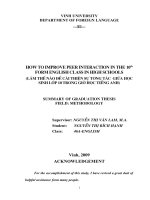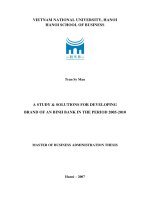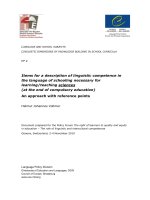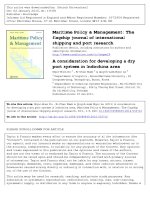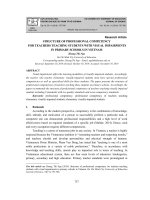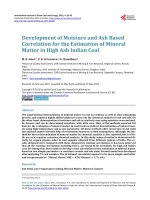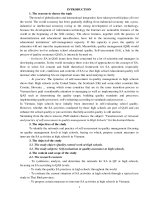MEASURES FOR DEVELOPING STUDENTS'' REVERSIBLE THINKING COMPETENCE IN TEACHING FUNCTIONS AND GRAPHS IN HIGH SCHOOLS
Bạn đang xem bản rút gọn của tài liệu. Xem và tải ngay bản đầy đủ của tài liệu tại đây (410.22 KB, 11 trang )
Vinh University Journal of Science, Vol. 51, No. 4B/2022, pp. 49-59
MEASURES FOR DEVELOPING STUDENTS'
REVERSIBLE THINKING COMPETENCE
IN TEACHING FUNCTIONS AND GRAPHS IN HIGH SCHOOLS
Thai Thi Hong Lam, Nguyen Thi My Hang, Truong Thi Dung
Faculty of Mathematics, School of Education, Vinh University, Vietnam
Received on 14/7/2022, accepted for publication on 19/9/2022
DOI: />
Abstract: The reversible thinking is the way of thinking in two opposite
directions, which then support each other to help people perceive and solve problems
flexibly and effectively. In this article, we mention manifestations of students'
reversible thinking competence in teaching functions and graphs and propose measures
to foster this ability in order to contribute to improving the quality of teaching
mathematics at high schools.
Keywords: Reversible thinking competence; functions and graphs.
1. Introduction
The reversible thinking is a familiar type of thinking related to the observation of
things and phenomena in opposite directions but mutually supporting each other and
flexibly applied in aspects of life.
Thinking in two opposite directions helps to limit the mistakes of “one-way
thinking”. For example, in the field of journalism, if using the mathematical the proof-
by-contradictory method to describe information, it can create a high degree of
originality and persuasion. Applying the inverse clause structure, the antithesis can also
create novel ways of expressing information.
When lecturing the Mathematics at high school as well as the Functions and
Graph subjects, the exploitation and application of two-way correlations will help
students in dealing with related issues, contribute simultaneously to fostering students'
reversible thinking competence.
2. Research content
2.1. Reversible thinking competence
In previous mindset research studies, the phrase “reversible thinking” was hardly
known in the rest. The reason is that there is no definition that discusses reversible
thinking explicitly with its sufficient connotation and denotation. However, the aspects
related to reversible thinking have mentioned in research works. J. Piaget had conducted
his investigation on the structure of thinking manipulation. The results indicate that the
basic nature of the manipulative structures is reversibility, which is the capacity of the
human mind to move in both the forward and reverse directions. He argued that the
reversibility demonstrated when “manipulations and actions can be deployed in two
directions and understanding one of them elicits understanding of the other” (V. V.
Davudov, 2000).
Email: (T. T. H. Lam)
49
T. T. H. Lam, N. T. M. Hang, T. T. Dung / Measures for developing students' reversible thinking…
In one study, the author V.A. Cruchetsky was interested in the reversibility of the
thinking process in mathematical arguments, which can be understood as changing the
direction of the thinking process in the sense of moving from forward thinking (from A
to B) to inverse thinking (from B to A). Reversible thinking competence was considered
as a component of students’ mathematical capacities (V.A. Cruchetsky, 1973).
In concerned research, published in 1997, the author G. Polya had referred to the
reversible reduction in mathematic problem solving. According to the author, “The
conversion from solving the original problem to solving the subproblems is called a
reversible or bidirectional reduction, or equivalent if the subproblem and the original
problem are approximately the same“ (G. Polya, 1997).
With the same interest in the possibility of reversing the thought process, Nguyen
Ba Kim took the destination of a fully understood process as the starting point for the
new one, while the starting point of the fully understood process was taken the
destination of the new one. That was considered by Nguyen Ba Kim as an expression of
the versatility of thinking (Nguyen Ba Kim, 2011). Together with Nguyen Ba Kim, Vu
Duong Thuy believes that the formation of opposite thinking in lecturing can be formed
simultaneously along with the formation of forward thought, which can be successfully
achieved through the parallel practice of forward and reverse transformation capacities
(Nguyen Ba Kim, Vu Duong Thuy, 2001).
Thai Thi Hong Lam belives that the reversible thinking is the way of thinking in
two opposite directions, which then support each other to help people perceive and solve
problems flexibly and effectively (Thai Thi Hong Lam, 2014). Reversible thinking is a
specific type of thoughtivity and it always associated with the circumstances which
contain matters to be considered in two opposite ways in a certain sense. From that
standpoint, according to the author: Reversible thinking competence is a psychological
features that reflects different individual finished levels when practicing reversible
thinking activities (Thai Thi Hong Lam, 2014). This capacity is only demonstrated when
performing reversible thinking activities and can be cultivated through practice. The
development of this capacity depends on the orientation of the lecturers, on the selection
of appropriate activities and on the organizing teaching for students to perform those
activities.
The above analysis shows that domestic and foreign authors have been interested
in studying the reversible thinking matters according to different concepts and objects.
2.2. Manifestations of students' reversible thinking ability in teaching
Functions and graphs
Based on the idea of Thai Thi Hong Lam regarding the reversible thinking
competence and the specification of the contents of Function and Graphs in high school
Math programs, when studying Functions and Graphs in high school, manifestations of
reversible thinking of students proposed as follows:
- Identify whether a given curve is a graph of a certain function
A given curve does represent a function if no vertical line can intersect the curve
more than once. Otherwise, that curve is not an instance of any graph of the function.
- Be able to determine the properties of functions based on the representation
formula, the variation table or the graph of the function; Be able to establish the
representation of a function when certain properties of the function are already known
50
Vinh University Journal of Science, Vol. 51, No. 4B/2022, pp. 49-59
Normally, for a function given by the formula, students will identify the
properties of the function, create the variation table and draw the praph of the given
function. This can be a manifestation of the forward direction of reversible thinking.
On the contrary, given a table of variation or a graph of a function, students are
able to determine the properties of that function. For example, students can find out the
evenness of a function by the feature that the graph takes the vertical axis as the axis of
symmetry; Students can determine the increasing of the function by the feature that the
graph “goes up” from left to right, ... That is, students have the ability to “read” function
graphs. From the properties of the function, students can find out the formula for that
function. This can be a manifestation of the opposite direction of reversible thinking.
- Be able to build a practical situation that “fits” with the function and vice
versa, be able to build compatible functions for practical situations
Each function can have practical situations that the mathematical model of these
situations is the function itself. Students are able to determine which practical situations
“fit” with the given function. Conversely, mathematical models can also represent
practical situation. Students know how to choose a mathematical model, in this case a
function, appropriate to each situation. For a better understanding, let us take a look at
specific examples: Given the function 𝑦 = 12𝑥. Indicate practical situations described
by the above function. In this case, let us consider two following cases:
o Case study 1: The selling price per kilogram of rice is 12 thousands dong.
Thus, the corelation between the returned money y (in thousands dong) and the sold
quantity of rice x (in kilograms) can be expressed by the function 𝑦 = 12𝑥 .
o Case study 2: Taxi rental cost is 12 thousands dong per kilometer. So if
the taxi rental distance is x km long, the amount to be paid y (in thousands dong) is
calculated according to the formula: 𝑦 = 12𝑥.
- Capable of turning the matter upside down, apply the necessary-and-sufficient
problem
Specifically, students have the following symptoms: Set up inversion clauses
when learning theorems; Apply necessary conditions, sufficient conditions, necessary
and sufficient conditions when learning definitions; Apply necessary conditions,
sufficient conditions, necessary and sufficient conditions when learning the topic of
Functions and graphs, including definitions, properties, and problem-solving methods.
In Mathematics, logical operations, the necessary, sufficient, necessary and
sufficient conditions of a clause are frequently used. The understanding of what are
necessary and sufficient conditions as well as the identification of problems of
necessary and sufficient form, exploiting the mutual correlation between them will help
students more convenient in finding ways to solve problems. We go through the
following case study, when teaching the theorem: “Assume f reaches its maximum at
point 𝑥0. If f has a derivative at 𝑥0, then 𝑓′(𝑥0) = 0” (Doan Quynh, Nguyen Huy Doan,
2010). The reverse may not be true. The derivative 𝑓′ may be zero at the point 𝑥0 but
the function does not have a maximum at 𝑥0. For example, with the function 𝑓(𝑥) =
𝑥3. Considering at point 𝑥 = 0, we have 𝑓′(𝑥) = 3𝑥2 and 𝑓′(0) = 0. However, f does
not reach its maximum at point 𝑥 = 0, because 𝑓′(𝑥0) = 0 for all 𝑥 ≠ 0, f is increasing
51
T. T. H. Lam, N. T. M. Hang, T. T. Dung / Measures for developing students' reversible thinking…
on R. Thus, the above theorem is only a necessary condition for the function to reach
its extreme point. Many students are not aware of this problem, leading to mistakes in
solving extreme math problems.
- Recognizing how to solve a problem by considering the inverse problem or
exploiting a two-way correlation between objects
For example, with the problem of the intersection of two graphs, there are
following conclusions: The number of intersections of the praph of function 𝑦 =
𝑓(𝑥) (𝐶1) and of the function 𝑦 = 𝑔(𝑥) (𝐶2) is equal to the number of solutions to the
equation of the coordinates of their intersection 𝑓(𝑥) = 𝑔(𝑥) (∗). The number of
intersections of (𝐶1) and (𝐶2) is sometimes determined based on the number of solutions
to the equation (∗). The number of solutions to the equation (∗)(or argument in terms of
the number of solutions of (∗)) can also be determined, conversely, based on the number
of intersections of (𝐶1) and (𝐶2). Normally, the equation (∗) can be converted to a
quadratic equation, while the number of intersections of (𝐶1) and (𝐶2) is based on the
number of intersections of the line 𝑦 = ℎ(𝑚) with the same direction as 𝑂𝑥 and the curve
𝑦 = 𝑔(𝑥) by isolating parameter. Applying this conclusion means that students already
know how to exploit the two-way correlation between to objects, namely the “the number
of intersections of the function graph” and “the number of solutions of the coordinate
equation”.
- Evaluating the cognitive and problem solving process
Re-considering is self-criticism, self-review, re-evaluating the cognitive and
problem-solving process which has been self-performed, although there was confidence
in the obtained results as well as the methods used previously. This manifested in the
ability to question oneself and self-answer the questions such as: Is the result correct or
incorrect? Have the cases fully considered? Is there another solution? What would be the
result if the problem reversed, enlarged or narrowed?
The review of the cognitive and problem-solving process helps students realize
their strong points, shortcomings, fund of knowledge and experiences for timely
adjustment and supplementation. Thus, the reviewing process will help students have
more solid, deeper and more extensive knowledge, and at the same time, contributes to
the development of critical thinking, self-regulation and self-direction for students. In
this regard, let us consider the following case: To assert that the function 𝑦 = 2𝑥 + 1 is
not even, many students prove 𝑓(𝑥) ≠ 𝑓(−𝑥) with ∀𝑥 (this is not true when 𝑥 = 0),
without knowing that the negation of the statement “true for all values of x” is the
statement “false” with at least one value of x”. Thus, just pointing out for example
𝑓(1) ≠ 𝑓(−1).
- Be able to solve mathematical matters in a distinguished, unique solution
People who have reversible mindset refuses to think in one direction, according to
the habit of doing or the opinion of the majority, but also flexibility think in the opposite
direction, reconsidering the issue from the opposite angle. This often results in a quick,
easy, and unique solution to solve problems. To illustrate this observation, let us consider
the following specific case: Find the maximum and minimum value of a function 𝑦 =
2𝑥2 + 𝑥 − 3. Typically, the majority of students in grade 10 come up with two solutions:
52
Vinh University Journal of Science, Vol. 51, No. 4B/2022, pp. 49-59
o Solution 1: Investigate and plot graphs of quadratic functions. The result
for the minimum value of the function is − 25 and the function has no maximum value.
8
o Solution 2: Transform the given function to become: 𝑦 = 2𝑥2 + 𝑥 − 3 =
2 (𝑥 + 1)2 − 25 ≥ − 25 with ∀𝑥. From there, determine the minimum value of the
4 8 8
function is − 25.
8
Contrary to the above solutions, by exploiting the meaning of the concept of
maximum value and minimum value of a function, students have provided the following
solution: Supposing we have to find the extremes of the function 𝑓(𝑥) which has a values
domain D. Let y be a value of 𝑓(𝑥) with 𝑥 ∈ 𝐷 meaning that there is a solution of the
equation 𝑓(𝑥) = 𝑦. Finding the conditions for equation 𝑓(𝑥) = 𝑦 to have a solution
usually leads to the expression 𝑚 ≤ 𝑦 ≤ 𝑀. Thence inferred min 𝑓(𝑥) = 𝑚 with 𝑥 ∈ 𝐷
and max 𝑓(𝑥) = 𝑚 with 𝑥 ∈ 𝐷.
The detailed solution is as follows: Let y be a value of 𝑓(𝑥), we have: 𝑦 = 2𝑥2 +
𝑥 − 3 ↔ 2𝑥2 + 𝑥 − 3 − 𝑦 = 0 (1).
The condition for the quadratic equation (1) to have a solution is: ∆≥ 0 ↔ 8𝑦 +
25 ≥ 0 ↔ 𝑦 ≥ − 25. So, the minimum value of the function is − 25.
8 8
This solution also works for the problem of finding the maximum and minimum
value of the function 𝑦 = 𝑎𝑥 , specifically as follow: The tabulation of variation to 2+𝑏𝑥+𝑐
𝑚𝑥+𝑛
find the maximum and minimum value of a function on a given set can only be
performed by grade 12 students. However, this matter can be completely solved by
students in grade 10 by considering y as a parameter, transforming the given function
into a quadratic equation where x is an unknown. By applying the condition of having a
solution of the quadratic equation ∆≥ 0, the maximum and minimum values of the
function will be determined. Furthermore, by this solution, the existence of the value of x
for the function to reach the maximum/minimum value is always asserted.
- Proposing a flexible solution in taking the multiple-choice test
For multiple-choice exercises, students can deduce themselves to choose the most
appropriate result. However, with the short duration of the assignment, choosing the right
answer for each question is time consuming if only using the essay method, students
must be capable in flexible test-taking skills. Let us consider the following multiple-
choice question: The function 𝑦 = 𝑚𝑥3 − 𝑥2 + (𝑚 − 8)𝑥 + 1 is determined to be
increased on R if and only if:
A. 𝑚 ∈ 𝑅 B. 𝑚 ≤ 0 C. 𝑚 ≥ 0 D. 𝑚 ≥ 12+7√3
3
In case of following free-response method, starting from the lead sentence, students
will come up with steps as follows: Determine the value of m for the function 𝑦 = 𝑚𝑥3 −
𝑥2 + (𝑚 − 8)𝑥 + 1 to be increase on R. This matter is equivalent to finding m for the
derivative of the given function is not negative on R as well as finding m for the following
inequality is true: 3𝑚𝑥2 − 2𝑥 + 𝑚 − 8 ≥ 0, ∀𝑥 ∈ 𝑅. After considering the cases 𝑚 =
0, 𝑚 ≠ 0 and find out 𝑚 ≥ 12+7√3, option D will be determined to be correct. The above
3
53
T. T. H. Lam, N. T. M. Hang, T. T. Dung / Measures for developing students' reversible thinking…
steps indicate that the determination of the right choice takes a lot of time, especially in the
case of students who have poor skills in transformation and synthesizing solutions.
If the method of exclusion thinking is applied, that is to eliminate the noisy
choices among the given alternatives. In the above case, realize that the value 𝑚 = 0 is
in all three choices, A, B, and C. Therefore, replacing 𝑚 = 0 into the given function,
then there are two possibilities. If the requirements are satisfied, that is, the function f
increase, the option D can be eliminated; Otherwise, all three options A, B, and C can be
eliminated. Indeed, in this particular case, when 𝑚 = 0, the increment of the given
function is not satisfied, so D is the corrected answer. Thus, the direct solution in the
forward direction has been simplified by performing the opposite solutions which goes
from the answer to evaluate the satisfaction of the matter.
3. Solutions for fostering reversible thinking capacity for students in
teaching Functions and graphs in high schools
3.1. Practice the skills of “reading, writing and drawing” graphs for students
In teaching Functions and Graphs at high school, students should be assigned to
do the following activities to master the skills of “reading”, “writing”, “drawing” the
correct graph of functions, thereby developing their reversible thinking:
- Set up the variation table and draw the graph of the function.
- Set up the formula to represent the function from the graph or from the variation
table of the function.
- Determine the function’s properties from the its graph or its variation table.
Take the following case study as an example. Given a function 𝑦 = 𝑓(𝑥),
determined on the interval [−3; 3] which is represented as in the following graph.
Figure 1: Illustrative examples for solutions to develop reading,
writing and drawing skills
Requirement: a) Calculate 𝑓(−2); 𝑓(3); 𝑓(0).
b) Determine the maximum and the minimum values in [−3; 3].
c) Determine the even and oddness of the function.
d) Determine the formula for the function.
In this case, the purpose of requirements a, b and c is to practice for students the
skills of “reading” from graph of functions. Meanwhile, the requirement d aims to
practice the writing skill for students.
54
Vinh University Journal of Science, Vol. 51, No. 4B/2022, pp. 49-59
3.2. Practice the consideration of the inverse clause and correct application of
necessary-and-sufficient matters
- Practice for students to distinguish between necessary conditions, sufficient
conditions, necessary and sufficient conditions
This solution is illustrated by a specific case study. After studying the following
content: “If 𝑓′(𝑥) < 0 for all 𝑥 belongs to the interval (𝑎; 𝑏), 𝑓(𝑥) decrease on the
interval (𝑎; 𝑏)” (Tran Van Hao, Vu Tuan, 2008), students are required to find out the
condition of parameter 𝑎 for the function 𝑦 = −1 𝑥3 + 𝑎𝑥2 + (𝑎 − 2)𝑥 + 1 to be
3
decreased on R. This matter actually takes the form of necessary-and-sufficient, meaning
that all sufficient conditions (all values of 𝑎) for the function to be decreased on R, must
be find out. A number of the students gave their answers as follows:
The given function decreases on R, means that 𝑦′ < 0, ∀𝑥 ∈ 𝑅
↔ −𝑥2 + 2𝑎𝑥 + 𝑎 − 2 < 0, ∀𝑥 ∈ 𝑅
↔ ∆′< 0 ↔ 𝑎2 + 𝑎 − 2 < 0
↔ −2 < 𝑎 < 1
This answer is not correct. Counterexamples can be used to help students
discover their own mistakes, thereby self-checking and correcting the solution. Here, the
counter-example can be used is the existence of an decrease function when 𝑎 = −2. The
following is the correct answer:
The given function decreases on R, means that 𝑦′ ≤ 0, ∀𝑥 ∈ 𝑅
↔ −𝑥2 + 2𝑎𝑥 + 𝑎 − 2 ≤ 0, ∀𝑥 ∈ 𝑅
↔ ∆′ ≤ 0
↔ 𝑎2 + 𝑎 − 2 ≤ 0
↔ −2 ≤ 𝑎 ≤ 1
From the above example, to help students in providing the correct solution of
these types, teachers need to adjust the knowledge that students receive through the
above theorem. This can be through questioning to examine the correctness of the
opposite direction of the theorem.
- Forming a habit of considering the correlation between forward clause, inverse
clause, opposite clause and negative clause in studying a theorem to prove it or to
discover new knowledge
To illustrate the solution, let us consider the following case study. After lecturing
the definition of a function which a derivative at x0 , students are assigned to consider the
relation between the existence of a derivative and the continuity or the limit of the
function at x0 . Comes from the following forward clause: “If 𝑓(𝑥) has a derivative at 𝑥0
then 𝑓(𝑥) is continuous at 𝑥0”. After suggesting the students to state the inverse clause,
opposite clause and the negative clause, the following questions are then posed:
- If 𝑓(𝑥) has derivative at 𝑥0, is it continuous at 𝑥0 ?
- If 𝑓(𝑥) is continuous at 𝑥0, is there a derivative at 𝑥0?
- If 𝑓(𝑥) has no derivative at 𝑥0, can it be concluded that it is discontinuous at 𝑥0?
- If 𝑓(𝑥) is not continuous at 𝑥0, then how to conclude the derivative at 𝑥0?
Students should be encouraged to provide some counterexamples that indicate the
wrongful of the reverse of the theorem, then answer the abve questions. In case of
55
T. T. H. Lam, N. T. M. Hang, T. T. Dung / Measures for developing students' reversible thinking…
difficulties, counterexamples are given by the teacher and the students are asked to
consider the correctness of the statements. The correlation between the continuous,
derivative of a function and its graph visualization can also be exploited to help students
consider the relationship between the continuity and derivative of a function at 𝑥0 . Then,
students can answer the above questions as follows:
- If 𝑓(𝑥) has a derivative at 𝑥0 then 𝑓(𝑥) is continuous at 𝑥0. The reverse is
incorrect.
- If 𝑓(𝑥)is not continuous at 𝑥0 then there is no derivative at 𝑥0.
- If 𝑓(𝑥) has no derivative at 𝑥0 then 𝑓(𝑥)can be continuous at 𝑥0 or
discontinuous at 𝑥0.
- The graph of 𝑓(𝑥), which has a broken line at 𝑥0, is discontinuous at 𝑥0, there is
no derivative at 𝑥0.
- The graph of 𝑓(𝑥) is a solid line, so it is continuous at 𝑥0. Reversely, in case of
broken at a point 𝑥0, 𝑓(𝑥)has no derivative at 𝑥0.
3.3. Practice the skills of of using functions to solve practical situations and
designing practical situations that fit a given function
After lecturing the quadratic function, students are assigned to solve practical
problems, for example: Nam is standing at the footbridge of a three-story flyover in Da
Nang city. Knowing that the pylon tower has a parabolic form, the distance of the two
pylon towers is about 27 meters which has a height of 20 meters calculated from the
point on the ground, which is 2,26 meters away from the foot of the tower (Figure 2).
Please help Nam estimate the height of the top of the bridge tower (calculated from the
ground) (Ha Huy Khoai, 2021).
Figure 2: Practical situation, solved by the function method
The pylon tower has a parabolic form, so the 𝑂𝑥𝑦 axis system is chosen, in which
one foot of the tower is located at the origin, the other foot is located on 𝑂𝑥. The graph
representing the tower, in the form of a parabola, has the following formula: 𝑦 = 𝑎𝑥2 +
𝑏𝑥. To simplify the matter, assuming that each meter length corresponds to a unit in the
coordinate system, because the tower is a downward parabola, we choose a < 0. From the
given data of the issue, the graph of of the parabolic pylon tower as shown in Figure 3.
56
Vinh University Journal of Science, Vol. 51, No. 4B/2022, pp. 49-59
Figure 3: Diagram illustrating the practical problem
Since the distance of the two pylon towers is about 27 meters, there will be two
intersection between the graph and the 𝑂𝑥 axis, at 𝑥 = 0 and 𝑥 = 27, then we can
represent the function as 𝑦 = 𝑎𝑥(𝑥 − 27).
According to the issue provided, pylon tower is observed to have a height of 20
meters calculated from the point on the ground, which is 2,26 meters away from the foot
of the tower. From there determine the point on the graph, named A, which has a X-
coordinate of 𝑥𝐴 = 2,26. The Y-coordinate of A is 𝑦𝐴 = 𝑎𝑥𝐴(𝑥𝐴 − 27) = 20, so 20 =
𝑎. 2,26. (2,26 − 27) ↔ 𝑎 = − 4000 .
11187
Thus, we have the equation representing the pylon tower of the bridge as:
𝑦 = − 4000 . 𝑥. (𝑥 − 27) = − 4000 . 𝑥2 + 12000
11187 11187 1243
Notice that the height of the tower is the Y-coordinate of the top of the parabola,
which has the coordinate (27 ; 65,16), meaning that the height of the tower is
2
approximately 65 meters.
On the contrary, for a quadric function, students are requested to identify a
practical situation which has a mathematical model suitable for that function, for
example: Given the function 𝑦 = 5. 𝑥2 with the the domain 𝐷 = [0,5]. Point out a
practical situation in physic that described by the above function.
In order for learners to perform the required activities, the teacher prompts by
asking questions about which physical phenomenon is described by the given function? It
is necessary to adjust the situation to suit the defined domain of the function. With that
pedagogical impact, learners will be associated with the following physical formula ℎ =
𝑔𝑡 , which describe the distance of a free falling object from the initial position, 2 𝑔 ≈
2
10 𝑚/𝑠2. The phenomenon of free falling objects in Physics becomes the focus of
attention of learners in the issue of situation building. However, the defined domain of
the given function is a matter of concern for the appropriate modification. Obviously, if
the given function describes a free falling object which hits the ground in 5 seconds,
meaning that the initial height of the object, compared with the ground, must be 125
meters. Students can make the following statements: An object is dropped freely from a
57
T. T. H. Lam, N. T. M. Hang, T. T. Dung / Measures for developing students' reversible thinking…
height of 125 m. The distance y of the object after x seconds from the initial position is
𝑦 = 5𝑥2; 𝑥 ∈ [0; 5].
The above example is just a specific case of finding a suitable practical situation
with a quadratic function. It should be noted that uniformly variable motions in
physics, described by formula 𝑆 = 𝑣0𝑡 + 𝑎𝑡 , can be used to design teaching according 2
2
to the above intention. The above two teaching circumstances have help students
approach the concept of quadratic functions from practice, and vice versa, practical
application of quadratic functions. And so, it has contributed to fostering reversible
thinking ability for students.
3. Conclusion
Competence development for high school students is the goal of the general
education program and the Math program in particular, in which the reversible thinking
competence plays a key role in forming for students the ability to be flexible and creative
in problem detection and problem solving. By describing the manifestations of students’
reversible thinking ability in teaching Functions and Graphs in high schools, we have
proposed three pedagigical measures to help teachers meet the requirement of the topic
and simultaneously contribute to fostering reversible thinking ability for students.
REFERENCES
V. A. Cruchetsky (1973). Psychology of mathematical ability of students. Hanoi:
Education Publishing House.
V. V. Davidov (2000). Types of generalization in teaching. Hanoi National University
Publishing House.
Tran Van Hao (Editor General), Vu Tuan (Editor), 2008. Analysis 12. Vietnam
Education Publishing House.
Nguyen Ba Kim (2011). Math teaching methods. Pedagogical University Publishing
House.
Nguyen Ba Kim (Editor), Vu Duong Thuy (2001). Teaching Methods of Mathematics
(General part). Education Publishing House.
Ha Huy Khoai (General Editor), Cung The Anh, Tran Van Tan, Dang Hung Thang (Co-
Editor), 2021. Math 10 - Volume 2. Vietnam Education Publishing House.
Thai Thi Hong Lam (2014). Strengthening reversible thinking competence for students in
teaching Mathematics at high schools. Thesis of Doctorate in Educational Science.
G. Polya (1997). How to solve the problem? Education Publishing House.
Doan Quynh (General Editor), Nguyen Huy Doan (Editor), 2010. Advanced Calculus 12.
Vietnam Education Publishing House.
58
Vinh University Journal of Science, Vol. 51, No. 4B/2022, pp. 49-59
TÓM TẮT
MỘT SỐ BIỆN PHÁP PHÁT TRIỂN NĂNG LỰC
TƯ DUY THUẬN NGHỊCH CHO HỌC SINH
TRONG DẠY HỌC CHỦ ĐỀ HÀM SỐ VÀ ĐỒ THỊ
Ở TRƯỜNG TRUNG HỌC PHỔ THÔNG
Thái Thị Hồng Lam, Nguyễn Thị Mỹ Hằng, Trương Thị Dung
Khoa Toán, Trường Sư phạm, Trường Đại học Vinh, Việt Nam
Ngày nhận bài 14/7/2022, ngày nhận đăng 19/9/2022
Tư duy thuận nghịch là cách suy nghĩ theo hai chiều hướng trái ngược nhau
nhưng tương hỗ lẫn nhau, giúp con người nhận thức và giải quyết vấn đề một cách linh
hoạt, hiệu quả. Trong bài báo này, chúng tôi đề cập đến một số biểu hiện của năng lực tư
duy thuận nghịch của học sinh trong dạy học chủ đề Hàm số và đồ thị và một số biện
pháp bồi dưỡng năng lực này nhằm góp phần nâng cao chất lượng dạy học toán ở trường
trung học phổ thông.
Từ khóa: Năng lực tư duy thuận nghịch; chủ đề Hàm số và đồ thị.
59
